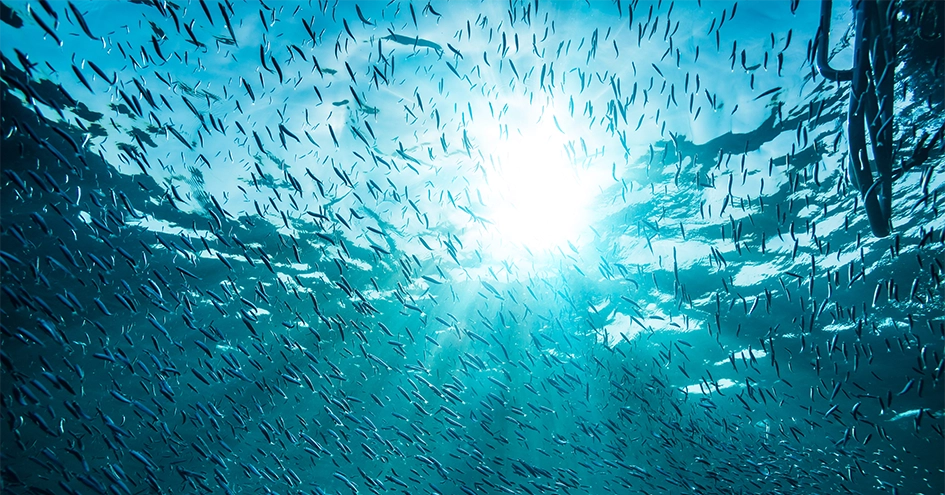Marine ecosystem conservation is essential to ensuring the sustainability of fishing activities. To this end, we ensure that our Private Brand and perishable fish products do not contribute to the overexploitation, depletion or extinction of species.

In 2024, we sold more than 200 species of fish, continuing to invest in diversifying our assortment as a way of reducing pressure on the most consumed fish species. The share of wild-caught fish decreased compared to the previous year (7 p.p. less), accounting for 61% of total consumption, while fish sourced from aquaculture accounted for 39% (up 7 p.p. compared to 2023). The share of fish sourced from aquaculture increased as a result of the consolidation of the investments we have made in this system, which can help to reduce the pressure on wild fish stocks, particularly on species most sought after by consumers, such as salmon, sea bream, sea bass, shrimp and trout.
Origin of Private Brand and Perishable Fish
in kg (2024)
Impact assessment and mitigation actions
In 2024, and in line with our commitment to annually monitor the conservation status of the wild-caught fish species sold in our stores, we once again carried out this assessment using data from the IUCN1. The IUCN categorises the different levels of threat as follows: Vulnerable (low risk), Endangered (medium risk) and Critically Endangered (high risk)2. The Not Evaluated, Data Deficient, Least Concern or Near Threatened categories are not considered threatened categories.
Like the previous year, around 35% of wild-caught fish in our Private Brands and perishables were listed as Vulnerable (representing the lowest level of risk) and more than half (51%) of our wild-caught fish purchases do not present a conservation risk (Near Threatened and Least Concern categories). The purchase of fish listed as ‘Not Evaluated’ by the IUCN also increased (6 p.p. more compared to 2023), due to the sale of the Merluccius hubbsi hake species, of which there were no purchases in 2023. No purchases of species considered Critically Endangered or Endangered were made.
Conservation satus of wild fish species
in kg (2023-2024)
We have defined concrete actions to mitigate the negative impacts of our activity on marine ecosystems for each of the three levels of conservation risk (high, medium and low), including:
- banning the purchase and sale of species listed as high risk (Critically Endangered) and for which there are no specific extraordinary permits or whose aquaculture production is not ensured across all stages of its life cycle.
- banning the sale of species listed as medium risk (Endangered) whenever they are not 100% sourced from aquaculture and/or from sustainably managed stocks and/or that do not have a certificate of sustainability (e.g. MSC or ASC).
- limiting promotional activities with species listed as low risk (Vulnerable) whenever they are not sourced from aquaculture and/or from sustainably managed stocks and/or that do not have a certificate of sustainability (e.g. MSC or ASC).
The table below depicts the level of compliance with the commitments at each of the three levels of conservation risk3.
IUCN Red List category |
|
Commitment |
|
Compliance in 2024 |
||||||
|---|---|---|---|---|---|---|---|---|---|---|
Critically Endangered |
|
Only the European eel (Anguilla anguilla)1 falls into this risk category. We stopped selling this species in our stores in 2016. In the assessment carried out in 2022, two other commercial species were identified under this level of risk: the Siberian sturgeon (Acipenser baerii) and the school shark (Galeorhinus galeus). In 2024, we only sold the species Acipenser baerii, ensuring that it was sourced from aquaculture for its entire life cycle. |
|
100% |
||||||
Endangered |
|
We identified seven species falling under this category, to which we applied the foregoing measure: shortfin mako (Isurus oxyrinchus); striped catfish (Pangasianodon hypophthalmus)2; smooth-hound (Mustelus mustelus); black hake (Merluccius senegalensis); undulate ray (Raja undulata), sandy ray (Raja circularis) and American plaice (Hippoglossoides platessoides). |
|
100% |
||||||
Vulnerable |
|
We identified 15 species in this risk category, for which we limited promotional activities. |
|
100% |
||||||
|
||||||||||
Traceability and biodiversity preservation
Our commitment to preserving marine ecosystems is evident in the diversity of FAO areas from which we source more than 80% of the wild-caught fish we sell. In 2024, approximately 60% of our assortment was sourced from FAO Area 27 – Northeast Atlantic4. Other important fishing areas include FAO Area 34 – East Central Atlantic (7%), FAO Area 87 – Southeast Pacific (7%), FAO Area 41- Southwest Atlantic (5%) and FAO 61 – Northwest Pacific (4%). Analysing traceability down to catch area level confirmed that more than half of the wild-caught fish sold in our stores sourced from these regions has no conservation risk (50% listed as Least Concern and 1% as Near Threatened), and 33% is listed in the lowest conservation risk category (Vulnerable). Around 17% of wild fish have not been assessed or have insufficient data on their conservation status.

As regards the sustainability status of fish stocks in the two most representative subareas [Norwegian Sea, Spitzbergen and Bear Island (FAO 27.2), and the Barents Sea (FAO 27.1)], the wild-caught fish listed as “Vulnerable” represents 48% and 93% respectively. In both regions, this assessment reflects the predominance of Atlantic cod (Gadus morhua) in our fish assortment, which is also listed as Vulnerable. This species has been subject to strict monitoring and management to ensure sustainable fishing. Cod populations in these areas vary greatly, with periods of abundance followed by declining biomass levels5.
Origin of wild fish by FAO
in kg (2024)
With regard to fish caught in Portuguese waters (FAO 27.9) and in the rest of the North-East Atlantic area (FAO 27), horse mackerel (Trachurus trachurus) and bigeye tuna (Thunnus obesus) stocks are the most representative among the species listed as Vulnerable (29% and 7%, respectively). The biomass levels of all horse mackerel stocks in these regions are above the limit reference point, and they have full reproductive capacity6. In respect of Atlantic bigeye tuna, stocks are currently overexploited but not overfished7.
Only a small proportion of the species we sell caught in the Eastern Central Atlantic (FAO 34) and the Southeast Pacific (FAO 87), 22% and 11% respectively, are listed as Vulnerable. In both cases, the bigeye tuna (Thunnus obesus) was the most representative species. The stock of this species in the Eastern Central Atlantic is currently overexploited but not overfished8, while the biomass levels of the stocks of the Southeast Pacific have been increasing due to the species conservation measures, so this stock is neither overexploited nor overfished8.
Regarding FAO Area 27.3 (Skagerrak, Kattegat, Sound, Belt Sea, and Baltic Sea) and FAO Area 27.4 (North Sea), almost the entire quantity of fish sold is at listed as Least Concern (100% and 99%, respectively). In the case of the Southwest Atlantic regions (FAO 41), 17% of the species are Vulnerable, the bigeye tuna (Thunnus obesus) being the most represented species, the stock of which is overexploited but not overfished8.
Also noteworthy is the Pacific Northwest area (FAO 61), predominantly made up of species not evaluated by the IUCN (94%), such as the Asian hard clam (Meretrix lyrata).
Tuna, in particular Atlantic bigeye tuna, is one of the most relevant species in terms of conservation risk, mainly due to overfishing and the pressure on the stocks we source from. In 2024, we were able to trace 42% of our consumption of Private Brand tuna and perishables down to vessel level (our commitment is to guarantee full traceability by 2026). This commitment to traceability is essential to monitoring the fishing practices associated with this species, allowing us, where necessary, to define additional criteria to help reduce the likelihood of overfishing.
1 Assessment is carried out using 2024 data from the IUCN Red List of Threatened Species, accessed through the Integrated Biodiversity Assessment Tool (IBAT). This data is provided by BirdLife International, Conservation International, IUCN and UNEP-WCMC.
2 For the purposes of this analysis, the Extinct in the Wild category is not considered since the species analysed are caught in the wild.
3 More information available at https://www.iucn.org/.
4 Includes the Barents Sea (FAO Area 27.1), Norwegian Sea, Spitzbergen and Bear Island (FAO 27.2), the interconnected Skagerrak, Kattegat, Sound, Belt and Baltic Seas (FAO 27.3), North Sea (FAO 27.4) and Portuguese Waters (FAO 27.9) and other subareas.
5 ICES. 2024. Cod (Gadus morhua) in subareas 1 and 2 north of 67°N (Norwegian Sea and Barents Sea), northern Norwegian coastal cod. In Report of the ICES Advisory Committee, 2024. ICES Advice 2024, cod.27.1-2coastN.
6 ICES. 2024. Horse mackerel (Trachurus trachurus) in Division 9.a (Atlantic Iberian waters). In Report of the ICES Advisory Committee, 2024. ICES Advice 2024, hom.27.9a. Available at: ICES Report.
7 ICCAT. 2024. Executive Summary of the 2024 Bigeye Tuna Stock Assessment. International Commission for the Conservation of Atlantic Tunas. Available at: ICCAT Report.
8 IATTC. 2024. Stock Assessment Report for Bigeye Tuna (Thunnus obesus) in the Eastern Pacific Ocean. Inter-American Tropical Tuna Commission. Available at: IATTC Report.
